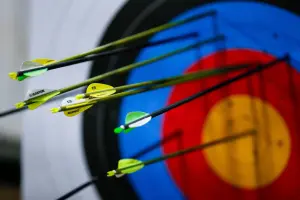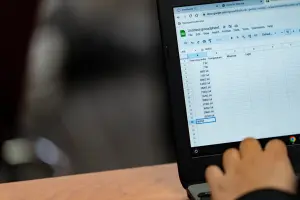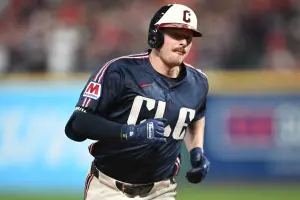
(*) ROTISSERIE: Labadini's $9—Harder than you think
The Labadini Plan—named for Larry Labadini's historic team in an early LABR season—has been receiving some renewed interest lately. To recap, Labadini once drafted a team with nine $1 pitchers, focusing the rest of his $251 budget on offense. The idea was bound to theory that hitters are more stable commodities than pitchers, and so those are the more reliable draft-day investments. With a combination of plucking enough end-game pitching to supplement one's top-notch offense, and with a couple shrewd trades once you have a hitting-category cushion, you can convert a $9 pitching staff into a championship club.
Touts Ron Shandler and Glenn Colton were separately talking about wanting to try it this spring. And over at FanGraphs, Mike Podhorzer recently wrote a nice piece on the $9 staff. In his article, Podhorzer gave his reasons for the staff he would have selected, why he thinks it would be fun, why he thinks it would work better in shallower leagues.
I have the utmost respect for Podhorzer; he is a lot smarter than me. But I don't think it works better in shallower leagues. In fact, I think it's the opposite. So I emailed Podhorzer with the following thoughts:
1. You need a league where the pool of available relevant free agent pitchers is high, and the available relevant free agent hitters is low. The more shallow the league, the less that relievers are in play (reducing the relevant FA pitcher pool) and the more than there are hitters lying about who could make a difference. This is not the right FA pool for this strategy.
2. Relievers need to matter to ERA/WHIP. You need to be able to go in and judiciously select middle relievers to fill out your staff to boost your ERA/WHIP, while other teams chase fourth starters and such to make the most of those $20 pitcher investments across the board. That is where you get your leverage—$1 guys that keep your ERA/WHIP figures at pace with the bigger-money staffs. Additionally, you want to roster those relievers with the idea that you have a greater chance of getting lucky and finding that new closer is already on your roster and not in the free agent pool.
3. To win, you need to have overkill in hitting and trade it for the pitching you want. You need the other teams to be starved for your hitters. You need to be able to trade a real hitter—not flotsam that beats the other guy's flotsam. At the right moment, you can drive a profit with your trade.
4. Finally, the free agent pool is your friend when it fits your need—but not your adversaries' needs. In deeper leagues (LABR or Tout Wars AL/NL only, for example) there are plenty of free agent pitchers and few hitters. Prior research shows that about two-thirds of the offensive stats are rostered on draft day, but only one-third of pitching stats get rostered in a standard AL/NL only league in any given year. Think about how much of an advantage that gives you if you have a surplus of hitting and need pitching.
I asked Mike for a response/reaction to these points.
Mike: "Doug, I appreciate your thoughts. I don't disagree with anything you said, but unfortunately I maybe wasn't clear enough on what I was posting. It wasn't a true $9 pitching staff because I mentioned in my intro that I was only selecting starters since relievers are boring. So it was technically a $9 starting pitching staff. In a deeper league, of course relievers would be involved who you can get for $1 and could deliver at least a couple of bucks in value. I ignored that since again, it's just not fun talking about relievers. So I don't think there's really any response to your points."
Not fun talking about relievers?! (Insert sad emoticon of your choice). I love relievers! So I regrouped, and wrote back: "Ok, so if you were going to try Labadini, would you rather try it in a shallow league or deeper league? How would you do it for a shallower league?"
Mike: "I would probably still try it in a shallow league simply because your $1 pitchers are actually pretty decent and sometimes have breakout potential. In a deep league, your $1 starters are guaranteed crap. You'd have to really get lucky finding pitching in a deep league during the season to offset the damage your $1 guys have done to your ratios, unless you choose to dump wins and saves and just roster all relievers, unless there's an IP minimum.
"In a shallow league, I stockpile my reserve list with young breakout potential guys (I drafted Carrasco and Mejia to my bench in my 12-team mixed league) and figure at least one of them is going to hit. Take advantage of slow starters getting dropped and buy low on guys underperforming their SIERA (xERA) marks. All this is much tougher in a deep league. Underperformers won't get dropped."
Later, Mike added: “My quibble with your point #1 is that the pool of available relevant free agent pitchers is definitely high in a shallow league! I wouldn't consider it high in a deep league, though. Sure, it's higher than the hitters, but certainly not high in absolute terms. So I don't really think that's a point in using the plan in a deep league's favor.”
Mike is quite right about a $9 staff in a deeper league. The damage would be almost impossible to fix. And it is also a question of choosing whether to punt wins/strikeouts or ERA/WHIP—two categories either way. I think it takes a lot of guts to try a $9 pitching staff. It would be very hard to pull off. You don't get to control many—if any—of the slots you fill.
In my view, owners in deeper leagues should try something more along the lines of $30-40. You still get a sizeable advantage buying offense, and yet you give yourself a chance to buy 3-4 solid pitchers, leaving only 5-6 slot to backfill and replace.
That's what I have done that for the last three years in LABR-NL. I won in 2011, failed to place in 2012 and came a close second in 2013. For 2014, the jury is still out. A lot of it, as Mike points out, is hit or miss with early pitchers and how deep a hole you dig for yourself in April/May. You have to be ruthless with your pitching roster—cut underperformers quickly, as they are scrubs to begin with. Use reserve slots to roster more pitchers. Be creative with early DL slots to roster more pitchers. Don’t be afraid to select DL pitchers who will come back to their teams later. Be creative with minor leaguers who may come up in June or July. Use your FAAB budget to roster the pitchers you want in-season. Be active early and often on the trade wire.
You get a leg up with the different projections at BaseballHQ.com and FanGraphs. Use them. If you do use Labadini, let us know on the HQ Forums how you are doing.








